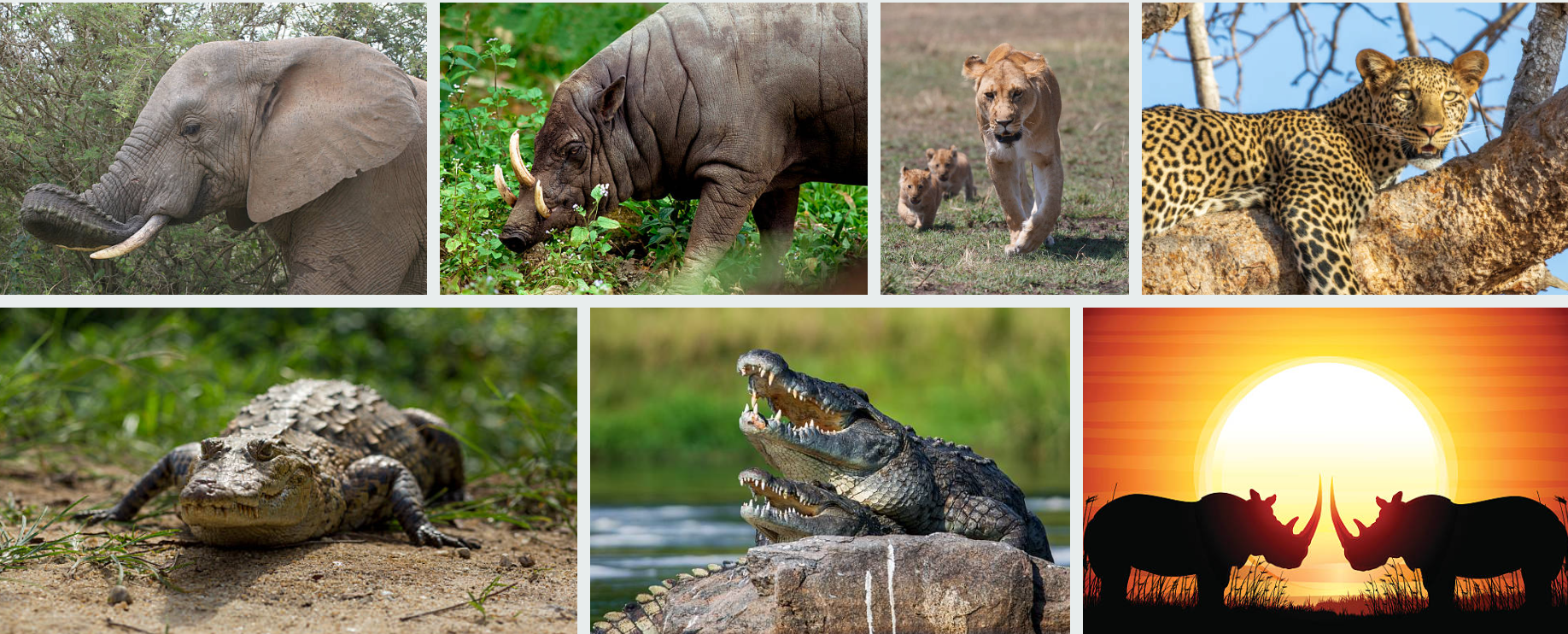The Most Dangerous Animals to Watch Out for on Safari
Deadly Safari Animals, Going on a safari is an exhilarating experience, offering the chance to witness majestic wildlife in their natural habitats. However, it’s crucial to remember that these animals are wild and unpredictable. While most safaris are conducted safely with experienced guides, certain animals pose significant threats due to their size, strength, aggression, or venom.
This article explores the most dangerous animals you might encounter on an African safari, their behaviors, and how to stay safe while observing them.
1. The African Elephant Deadly Safari Animals
Why They’re Dangerous
African elephants are the largest land animals, weighing up to 6,000 kg (13,000 lbs). Despite their generally gentle nature, they can become extremely aggressive when threatened, especially if they feel their calves are in danger.
Threats to Humans
-
Charging: Elephants can run at speeds of up to 40 km/h (25 mph). A charging elephant can trample vehicles and people.
-
Protective Mothers: Female elephants with calves are highly defensive and may attack without warning.
-
Musth Bulls: Male elephants in musth (a hormonal condition) are highly aggressive and unpredictable.
Safety Tips
-
Keep a safe distance (at least 30 meters).
-
Listen to your guide’s instructions—if an elephant flares its ears or trumpets loudly, it may be warning you to back off.
-
Avoid sudden movements or loud noises.
2. The Cape Buffalo (Syncerus caffer)
Why They’re Dangerous
Known as the “Black Death,” the Cape buffalo is responsible for more hunter deaths in Africa than any other animal. These massive herbivores are highly aggressive and have been known to ambush humans.
Threats to Humans
-
Unpredictable Charges: Buffaloes can charge without warning, using their sharp horns to gore and trample.
-
Group Attacks: If one buffalo is injured, the entire herd may attack in retaliation.
-
Bad Temperament: Old bulls, often solitary, are particularly aggressive.
Safety Tips
-
Never approach on foot—always stay in the vehicle.
-
If charged, do not run in a straight line—buffaloes have poor turning ability.
-
Keep a safe distance, especially from solitary males.
3. The Hippopotamus (Hippopotamus amphibius)
Why They’re Dangerous
Despite their docile appearance, hippos are extremely territorial and kill more people in Africa annually than lions or crocodiles. They are highly aggressive, especially in water.
Threats to Humans
-
Territorial Attacks: Hippos attack boats and humans who enter their waterways.
-
Speed & Strength: Despite their size, they can run at 30 km/h (19 mph) on land.
-
Powerful Jaws: Their bite force (1,800 psi) can crush bones instantly.
Safety Tips
-
Never get between a hippo and water—they flee to water when threatened and may trample anything in their path.
-
Avoid riverbanks at night when hippos graze on land.
-
Stay in the boat and avoid provoking them.

4. The Lion (Panthera leo)
Why They’re Dangerous
Lions are apex predators with incredible strength, speed, and hunting instincts. While they usually avoid humans, attacks do occur, particularly in areas where they’ve lost fear of people.
Threats to Humans
-
Opportunistic Attacks: Lions may see humans as prey, especially at night.
-
Protecting Cubs: Lionesses are fiercely protective and may attack if they perceive a threat.
-
Man-Eaters: Rarely, lions develop a taste for human flesh (e.g., the Tsavo man-eaters).
Safety Tips
-
Never walk alone at night in lion territory.
-
Maintain eye contact if confronted—do not run (it triggers their chase instinct).
-
Stay inside the safari vehicle—lions see it as a single large entity rather than individual prey.
5. The Nile Crocodile (Crocodylus niloticus)
Why They’re Dangerous
Nile crocodiles are ambush predators with the strongest bite force of any animal (5,000 psi). They lurk underwater, waiting to drag prey in with a death roll.
Threats to Humans
-
Ambush Attacks: Crocodiles strike suddenly, pulling victims underwater to drown them.
-
Territorial Behavior: They aggressively defend their nesting sites.
-
High Fatality Rate: Few survive a crocodile attack due to blood loss or drowning.
Safety Tips
-
Never swim in rivers or lakes where crocodiles are present.
-
Stay at least 5 meters from the water’s edge.
-
Be extra cautious during breeding season (when they’re most aggressive).
6. The African Leopard (Panthera pardus)
Why They’re Dangerous
Leopards are stealthy, powerful, and highly unpredictable. Unlike lions, they are solitary and more likely to see humans as prey.
Threats to Humans
-
Stealth Attacks: Leopards ambush from trees or tall grass.
-
Strong & Agile: They can drag prey heavier than themselves up trees.
-
Urban Encounters: In some areas, leopards adapt to human presence, increasing attack risks.
Safety Tips
-
Avoid walking alone in dense bush areas.
-
Do not crouch or run—stand tall to appear larger.
-
Be cautious at dawn/dusk when leopards are most active.
7. The Black Mamba (Dendroaspis polylepis)
Why They’re Dangerous
Africa’s deadliest snake, the black mamba, is highly venomous, fast (up to 20 km/h), and aggressive when cornered.
Threats to Humans
-
Neurotoxic Venom: A single bite can kill within hours without antivenom.
-
Aggressive Nature: Unlike most snakes, mambas may chase humans if threatened.
-
Multiple Strikes: They attack repeatedly, injecting large amounts of venom.
Safety Tips
-
Wear closed shoes and long pants when walking in bush areas.
-
If bitten, seek antivenom IMMEDIATELY—every minute counts.
-
Do not provoke or attempt to handle the snake.
8. The Rhinoceros (Black & White Rhinos)
Why They’re Dangerous
Rhinos have poor eyesight but a strong sense of smell and hearing. When startled, they charge at speeds up to 55 km/h (34 mph).
Threats to Humans
-
Blind Charges: Rhinos may charge at perceived threats (including vehicles).
-
Sharp Horns: Their horns can impale or flip vehicles.
-
Territorial Males: Bulls are highly aggressive during mating season.
Safety Tips
-
Stay downwind—their sense of smell is acute.
-
If a rhino charges, try to hide behind a large obstacle (they have poor vision).
-
Never approach on foot—always stay in the vehicle.
9. The African Wild Dog Deadly Safari Animals
Why They’re Dangerous
Though less known, wild dogs are highly efficient hunters with a pack mentality that can turn aggressive toward humans.
Threats to Humans
-
Pack Hunting: They coordinate attacks, overwhelming prey.
-
Fearless Nature: Unlike lions, they rarely back down from a confrontation.
-
High Bite Force: Their strong jaws can inflict severe injuries.
Safety Tips
-
Never approach a pack, especially if they’re feeding.
-
Stay in the vehicle—they see it as a single entity rather than prey.
-
Avoid running—it may trigger a chase response.
10. The Mosquito (Anopheles spp.)
Why They’re Dangerous
While not a traditional safari threat, mosquitoes transmit deadly diseases like malaria, dengue, and yellow fever.
Threats to Humans
-
Disease Vectors: Malaria alone kills hundreds of thousands annually.
-
High Exposure Risk: Safari camps near water sources increase mosquito presence.
Safety Tips
-
Use insect repellent with DEET.
-
Sleep under mosquito nets.
-
Take antimalarial medication if visiting high-risk areas.
Staying Safe on Deadly Safari Animals
While encountering these animals is a thrilling part of the safari experience, respecting their space and behavior is crucial for safety. Always follow your guide’s instructions, remain inside the vehicle when advised, and avoid risky behaviors like approaching animals on foot.
By understanding these dangers and taking precautions, you can enjoy an unforgettable safari while minimizing risks. Remember: in the wild, you are a guest—always observe, never provoke.









